by Joy Livingwell
Conventional wisdom says grazing damages land -- yet the same land a few cattle or sheep damage today often supported thousands or millions of wild grazers less than 200 years ago.
John Mix Stanley, circa 1855 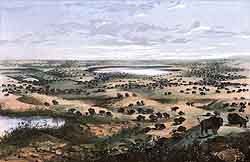 Working as nature's seeders, mulchers, and composters, bison helped build North America's deep prairie soils. They were aided by tens of millions of elk, deer, pronghorn antelope, and other grazers. |
Explorers' accounts tell of lush grass, flowing springs and rivers, and abundant game in areas that today are damaged or turning to desert. If grazing damaged land, nature could never have built those landscapes in the first place. What's going on?
And how can managers restore damaged land by putting animals back on it? It seems improbable, but it works.
What do grazers do in nature?
Under natural conditions, grazers are nature's gardeners:- Their hooves create seed-to-soil contact, helping dormant seeds to germinate and establish.
- They break soil crusts that keep seeds from growing.
- They trample standing vegetation into mulch that protects the soil and keeps it moist.
- Their guts act like living compost piles, turning vegetation into high-quality fertilizer.
- By pruning stale growth, they keep forage plants at peak production.
- Pruning a plant's top causes its roots to self-prune. These dead roots become new soil.
Thomas J. Elpel 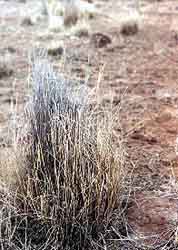 When grazers don't do their job in dry climates, you get this: dead gray growth shading the plant instead of mulching the soil, and crusted bare ground seedlings can't survive on. Result: desertification. |
It's an exquisitely balanced interplay of biological processes that let an estimated 60,000,000 bison build prairie soils up to 3 meters (9 feet) deep across the vast plains of North America. Today it supports millions of wildebeest, zebra, impala, and other game in East Africa.
But when humans exterminate predators and put up fences, the system breaks down. It depends on mobile herds -- tightly bunched against predators -- moving into an area, grazing and trampling it intensively, then moving off to escape their own dung and urine. This gives plants time to recover before the next graze -- to regrow not just their tops, but their roots as well.
Without predators, even wild grazers scatter over a landscape, bite the same plants again and again, and cause desertification just like domestic livestock.
Using livestock to heal land
Managers can re-create nature's conditions well enough to heal land by
Norman Neave 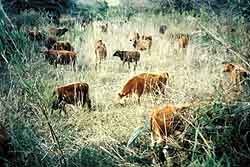 Portable fencing, high stock density, and frequent moves help cattle mimic the impact of wild herds. The grass gets a long recovery period between grazings.
Roger Bowe 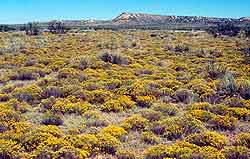 In 1986, this pasture was 11% snakeweed. The conventional "solution" -- killing weeds -- would worsen the real problems: low biodiversity and 46% bare ground.
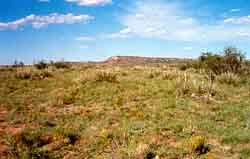 Holistic decision-making led to this result by 1990: 1% snakeweed, 30% bare ground, 9 new perennial grass species, and 3 meters (10 feet) of water in a well dry since the 1950s. |
- Using fences or herding to keep grazers bunched.
- Using salt, molasses, or other treats to get them excited so they knock down dead growth and trample soil, rather than stepping carefully. This isn't a great solution, because herds chased by predators run and trample a lot more. But it's a start.
- Limiting grazing periods, with enough rest between grazings for plants to recover fully.
Surprisingly, the key factor in making this all work long-term is holistic decision-making. This involves using everything we do already to make decisions, plus:
- Managing for what we want to happen (our goal), rather than just trying to avoid problems or reach narrow objectives.
- Treating nature as a complex whole that does things we can't predict simply from studying its parts.
- Monitoring our progress and correcting course to assure we get the results we want. The key is to track what actually happens, and make our course-corrections as early as possible -- and to stay on course when what we do works. How land responds depends on climate, weather, management, history (what seeds are in the ground, how much topsoil remains), and many other factors.
- Managing the whole to create social, ecological, and financial benefits.
- Using extra tools, techniques, and knowledge that support this process.
What results can this kind of land management produce?
Allan Savory 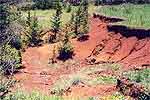 Kelly Pasztor 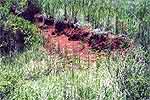 Even severe gullying can be healed by managed grazing and trampling. On Savory Center site. |
Financial benefits:
- Increased profitability.
- Decreased costs.
- Greater financial resilience.
- More money goes toward what people value.
Social benefits:
- Greater involvement by family, customers, and community members.
- Families get to stay on the land; ownership remains local.
- More viable local businesses; greater income for the community.
- More people see environmental restoration is possible and get to help it happen.
Kachana Pastoral Co. 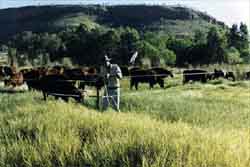 In 1992, each hectare of this area grew less than one day of food for a cow. In 2001, each hectare grew 800-1,100 stock-days of forage (320-450 stock-days per acre), harvested in 3 grazings. With plenty to eat, wildlife is returning. Article |
Environmental benefits:
- Greater biodiversity; return of native perennials and wildlife.
- Fewer predator and pest problems, due to better stock management and year-round food supplies for predators.
- Less flooding and erosion as water sinks into the soil instead of running off. Dry wells and springs start to produce water, seasonal streams flow year round again.
- Vegetation covers bare soil and gullies, eroded streams start to fill in.
- The ecosystem develops tremendous resiliency, and can weather droughts and heavy rains that used to cause major problems..
- Biological productivity and biodiversity increase, often dramatically. Forage production often doubles or triples.
Hope for the future
Capt. Albert Theberge, NOAA 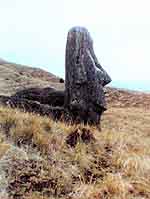 Easter Island was once forested. Resource depletion led to starvation and warfare that killed 90% of the people. With the trees gone, they could not build canoes to escape. |
Desertification and degraded land are age-old problems. When civilizations damage the resource base that sustains them, they collapse. Well-known examples include Mesopotamia and Easter Island.
Because of the long time spans involved, most people don't realize that the majority of the world's desert was created by people. For example,
- Once grassland and forest, North Africa grew grain to support the Roman Empire. Writing in 440 B.C.E., Herodotus praised Libya for its deep black soils and abundant springs.
- The desert surrounding Salt Lake City, Utah, U.S.A. had grass high enough to touch a horse's belly when Mormon settlers arrived in 1847.
- Until the arrival of humans, much of northwestern Australia was rain forest. Significant tracts survived under Aboriginal management.
Peter Donovan
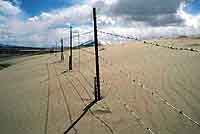 Advancing dunes near Hawthorne, Nevada. The western U.S.A. is one of the fastest-desertifying areas in the world. |
Today desertification is happening faster than at any time in human history. According to the United Nations Convention to Combat Desertification, desertification affects about one-sixth of the world's population and 70% of the world's drylands, amounting to 1/4 of the planet's total land area.
By managing holistically, we now have the ability to start turning the world's human-created deserts -- the Sahara, the Gobi, South Africa's Karoo, much of the western U.S.A. -- back into the grasslands and forests they once were. We can begin restoring our degraded landscapes in ways that provide abundant habitat for wildlife and grow topsoil. We can thus sequester carbon, increase the land's biological productivity, and work toward restoring nature to abundant good health.
And by ensuring a healthy nature and healthy agriculture, we can sustain civilization for ourselves and for future generations.
--Joy Livingwell
© 2002
Allan Savory 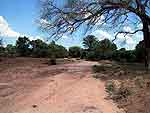 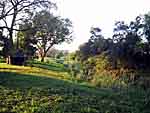 Hope for the future: even terribly damaged areas can be restored. These pictures were taken in the same area on the same day. The difference is the management. Article |
Related articles and links
Environmental restoration success stories
Tony & Jerrie Tipton 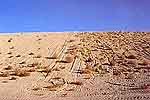 Conventional techniques failed to revegetate this old gold mine.
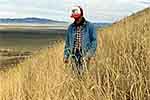 The restored land outperformed some nearby hayfields. On EcoResults! |
How and why this kind of environmental restoration works
Training -- how to monitor and heal land
- Land EKG is a method of monitoring landscape health in ways that give you useful information about what the land needs. Workshop schedule.
- Wayne Burleson teaches 1-2 day Pasture Walk workshops.
- Savory Center calendar of Holistic Management events and trainings. Learn land monitoring and holistic decision-making.